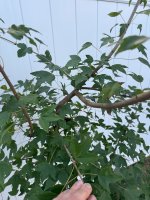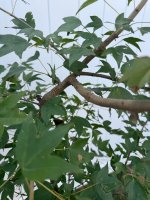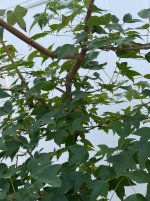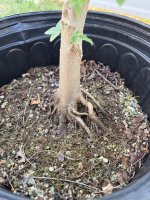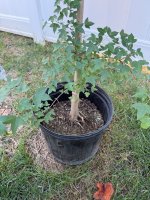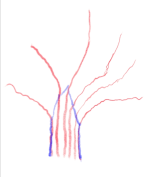Didn't read through the replies, so forgive me if I echo other responses. The thickness of the top doesnt matter, the base does at this point in development. Ultimately, the desired thickness will vary from tree to tree based on your goals. Do you want it to be a large tree, shohin, etc should be one of your initial questions to yourself. If it were mine, I would cover the roots with soil first and foremost. Exposed nebari don't develop as well as a buried one, it won't send out any new roots in the exposed areas. I wouldn't do anything till spring. Let it strengthen, and keep it fertilized, the healthier it is, the more growth it will reward you with. Every couple years you'll want to work the roots. One way people have a lot of success with tridents when building a nice nebari is to get a circular piece of thinner wood, use small nails or tacks to guide the roots into a more radial position. Don't drive the pins through the roots though, place them beside the roots to keep them aligned. The board will force the roots near the tree to remain shallow, and the more dense the roots become near the base of the tree, the more they will fuse. A bit of searching and you should be able to find some good info on this method.
Here is my understanding of why trees grow without taper in most cases, the reason in most cases we have to chop and regrow a new leader multiple times to build taper.
Any growth will cause thickening. The more tree, the more foliage, the more vascular tissue it requires. An elongating branch will thicken the entire area between it, and the roots, but not above the branch.
Example 1, forest trees generally abandon all lower branches and grow a canopy because of the competition for sunlight in a forest. This leaves all of the branches at the top, all adding thickness below the branches, creating a consistent trunk thickness all the way down the tree. Same as your tree, with all of the branches high on the trunk. The taper will begin at the lowest branch, and taper to the leader. This is also the reason many times air layers make better trees, taking the top where most of the branches were located gives better taper.(Pardon the crappy illustration)
View attachment 610217
Example 2, dwarfed trees, shrubs, bushes, etc have a growth habit generally desireable for bonsai because they aren't as predisposed to abandon their low branches. Assuming any tree has a consistent distribution of branches starting low on the tree, the taper should be consistent as well. Looking at a tree, the taper will begin at the first branch.
View attachment 610210
This is obviously a simplification. This also shows why we use sacrifice branches on our bonsai to correct taper issues. Also, one way to really see how thickening branches add girth to the trunk, look at a tree that has a slingshot V. Generally the thickness of the trunk below the V will be close to the combined thickness of the two top branches of the V. This is the reason we want junctions of 2, it gives a more desireable taper.
The more you allow all of the branches to elongate and thicken, the more your tree will thicken. Trident maples want to be the forest tree and will drop shaded branches. Before the spring push, you can remove all of the branches to a nub, leaving the leader alone and it should push branches all over the place, wire them to where they won't be shaded and they should put out better growth.
Hope this helps.

